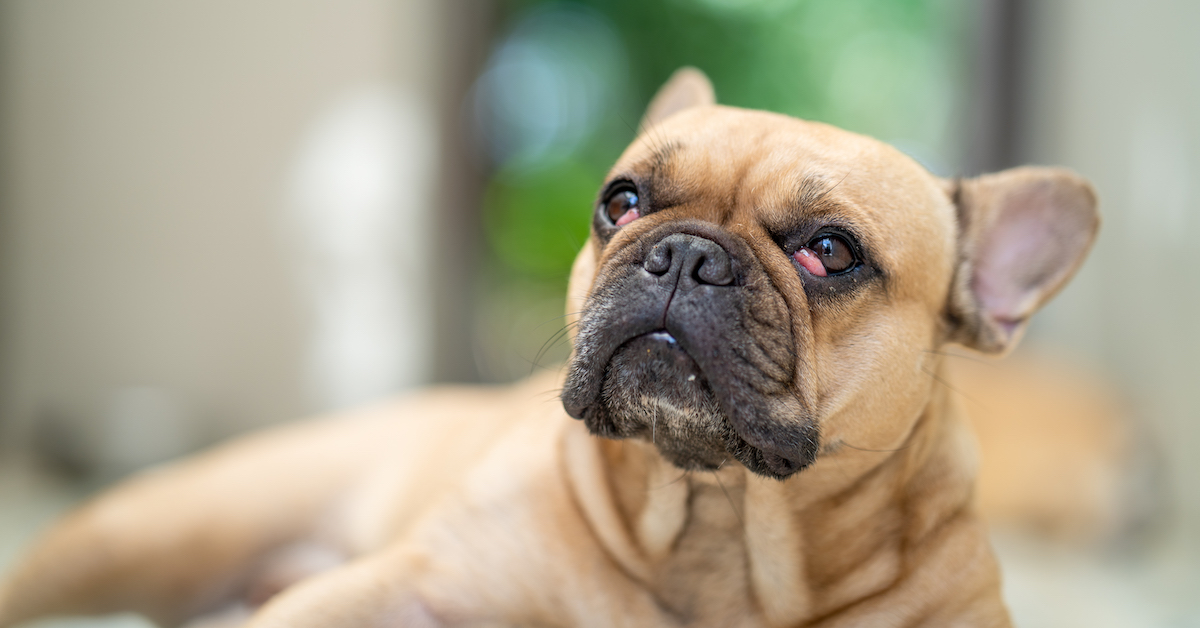Cherry Eye – What Is It and When to Seek Veterinary Care
Cherry eye in dogs can look scary but is typically not life-threatening to pets who receive prompt veterinary care.

Did you know that your dog has a third eyelid located in the inner corner of the eye? Also known as the nictitating membrane, this third eyelid is designed to keep the cornea moist and free of irritating debris. When the third eyelid gland becomes swollen and inflamed, it can prolapse or “pop out.” This condition is referred to as cherry eye.
What Is Cherry Eye in Dogs?
Cherry eye occurs when there is a prolapse of the nictitating membrane or third eyelid. The nictitating membrane is a tissue hidden in the corner of the dog’s eye that secretes tears. With the cherry eye, this membrane grows and starts to protrude from the eye, appearing as a pink bulge that is visible in the corner of the eye. It’s normal for dogs with cherry eye to also experience associated conditions like chronic dry eye and eye irritation. Cherry eye can affect any breed of dog and may occur in one or both eyes.
What Causes Cherry Eye in Dogs?
Cherry eye most commonly affects dogs under one year of age. This common condition develops when the small ligament responsible for holding the third eyelid in place overstretches or breaks. Veterinarians are not entirely sure why this occurs but cherry eye tends to occur in certain dog breeds, such as:
- English Bulldogs
- American Cocker Spaniels
- Pekingese
- Basset Hounds
- Shih Tzus
- Beagles
- Rottweilers
- Neapolitan Mastiffs
- Boston Terriers
- Lhasa Apsos
- Maltese
- Saint Bernards
- Shar-Peis
Other factors can also contribute to the development of cherry eye, such as eye trauma. Scratching or rubbing at the eye, being poked in the eye, and similar injuries can cause the ligaments in the third eyelid to weaken. Although the cherry eye in itself is not an infection, a prolapsed third eyelid can make the eye more susceptible to foreign bodies that can lead to infection.
What are the Symptoms of Cherry Eye?
Dogs with cherry eye may exhibit a variety of signs and symptoms. The most common symptom of cherry eye is a red swollen lump that develops in the corner of the eye closest to the dog’s muzzle. These lumps can range in size from relatively small to large enough to cover most of the eye. Your dog may also show other symptoms of cherry eye, such as discharge from the eye. However, discharge does not occur in all cases. Some dogs with cherry eye may scratch or paw at the eye which can further aggravate the swelling and irritation.
What Treatments are Available for Cherry Eye?
When a dog is first diagnosed with cherry eye, the initial recommended course of treatment is usually anti-inflammatory eye drops to reduce swelling. Many vets also prescribe antibiotic eye medication, especially if there is evidence of discharge from the affected eye. If the cherry eye persists or causes the dog discomfort, surgery may be needed to put the gland back into its proper location. In some cases, this treatment does not work and the gland needs to be completely removed.
There are three main techniques used in cherry eye treatment:
- Tucking Method – The tucking or “tacking” method is the traditional method for correcting cherry eye in dogs. This procedure involves placing a permanent, single stitch to draw the gland back into its proper position. While often successful, complications can arise if the tuck is not well anchored. If the stitch unties, the surface of the eye can become scratched.
- Imbrication Method – The imbrication or “pocketing” method of correcting a cherry eye is a newer technique. With this method, a section of tissue is removed from over the gland and small stitches are used to close the gap. The glands are pushed back into the proper place and the stitches eventually dissolve. Some complications can occur with this method, such as inadequate tightening of the tissue gap which can result in a reoccurrence of cherry eye.
- Gland Removal – While the removal of the third eyelid gland was once a common treatment, it is now typically used as a last resort. If the gland is removed, the upper eyelid gland is not able to produce sufficient tears, resulting in a thick yellowish discharge. As a result, the eye creates a binding pigment, a condition known as keratoconjunctivitis sicca, otherwise referred to as dry eye. Dry eye typically requires lifelong medication to avoid side effects like blindness.
When Should I Bring My Dog to the Vet?
If you suspect that your dog may have a cherry eye, you may be contemplating bringing him to the vet. Although cherry eye is not usually life-threatening, it is important to see your vet as soon as possible. If left untreated, the cherry eye could potentially cause damage to the tear duct, resulting in chronic dry eye. The eyelid gland can also become swollen and ultimately restrict blood flow, causing your dog to experience discomfort. This irritation may cause your dog to scratch or paw at his eye, increasing his risk of infection and damage.
Unfortunately, there is no way to prevent cherry eye in dogs. However, you can help your pet maintain good overall health by feeding him a healthy diet, providing lots of exercise, and staying up-to-date on all vaccinations and preventative care needs.
Ready to start saving money on pet wellness care?
Then take a look at Mint Wellness, the pet wellness plan that provides fast reimbursement on routine pet care. Save on vaccinations, wellness exams, preventatives, dental, and more!
Learn More


